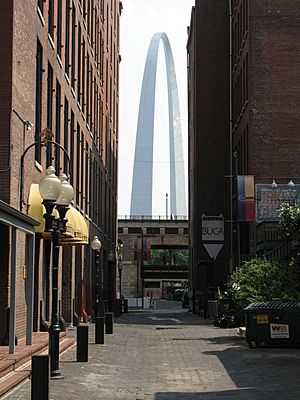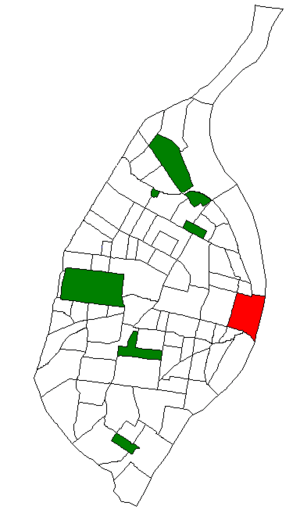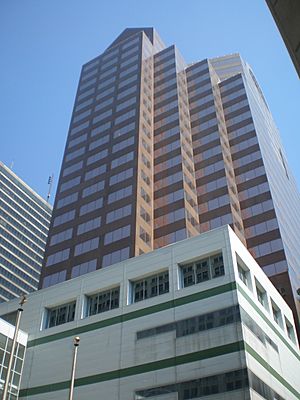Downtown St. Louis facts for kids
Quick facts for kids
Downtown
|
|
|---|---|
|
Neighborhood
|
|

The Gateway Arch from Laclede's Landing
|
|

Location (red) of Downtown within St. Louis
|
|
| Country | United States |
| State | Missouri |
| City | St. Louis |
| Wards | 7 |
| Area | |
| • Total | 1.01 sq mi (2.6 km2) |
| Population
(2020)
|
|
| • Total | 5,442 |
| • Density | 5,388/sq mi (2,080/km2) |
| ZIP code(s) |
Parts of 63101, 63102
|
| Area code(s) | 314 |
| Website | stlouis-mo.gov |
Downtown St. Louis is the main center of business in St. Louis, Missouri. It's a busy place for tourists and fun activities. Downtown St. Louis is bordered by Cole Street to the north and the Mississippi River to the east. To the south is Chouteau Avenue, and to the west is Tucker Boulevard. Many big companies have their main offices here. These include Stifel Financial Corp., HOK, and Spire Inc.
Contents
History of Downtown St. Louis
Early Days of St. Louis
The story of Downtown St. Louis begins with the city's founding. In 1764, Pierre Laclede chose this spot for a new settlement. He picked it because it was high above floods and close to the river. This made it perfect for trading goods, especially furs, with local Native American tribes.
In the beginning, Laclede was like the unofficial leader of St. Louis. People even called it "Laclede Village." He helped plan the streets and build the first homes. When France gave up its lands east of the Mississippi River to Great Britain, many French settlers moved to St. Louis. They wanted to avoid British rule. By 1776, St. Louis had about 300 people and 75 buildings.
Growth and Change
After the Louisiana Purchase in 1803, more people from the United States moved to St. Louis. The town grew quickly. By 1804, the population reached 900. When steamboats arrived in 1817, St. Louis became a very important trading hub. Goods could travel from the Gulf of Mexico all across the country using the river system.
By 1836, the city had 15,000 people. The downtown area started to become more about businesses than homes. Many people began to live in other parts of the city. A big fire in 1849 destroyed much of the downtown business area. But the city rebuilt and became a major commercial center again.
Modern Revival
In the late 1800s and early 1900s, Downtown St. Louis saw a lot of new buildings go up. It was a very busy place for business. However, by the mid-1900s, businesses started moving to the suburbs. This caused the downtown area to decline. Many old buildings were torn down for parking lots.
Since the early 1990s, St. Louis has worked hard to improve its downtown. Billions of dollars have been invested to bring new life to the area. Now, the population is growing again, and many new homes and businesses are being built.
Economy

Downtown St. Louis is home to the main offices of several large companies. These include Nestlé Purina PetCare, which makes pet food, and Peabody Energy Corporation, a big energy company. Ralcorp and Post Foods also have their main offices here.
Before it joined with American Airlines, Trans World Airlines (TWA) had its headquarters in One City Centre. The Federal Reserve Bank of St. Louis is also located downtown. It helps manage money for the central United States.
Education
The main office for St. Louis Public Schools is located in Downtown St. Louis. The St. Louis University School of Law (SLU LAW) moved to a new building downtown in 2013. In 2015, Webster University also opened a campus downtown.
Demographics
In 2020, Downtown St. Louis had a population of 5,442 people. The community is diverse, with people from many different backgrounds living there.

